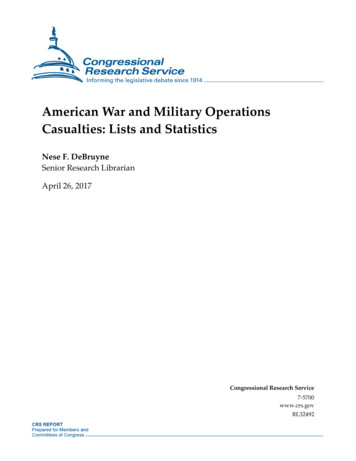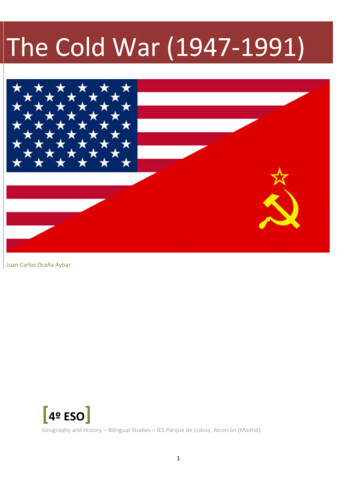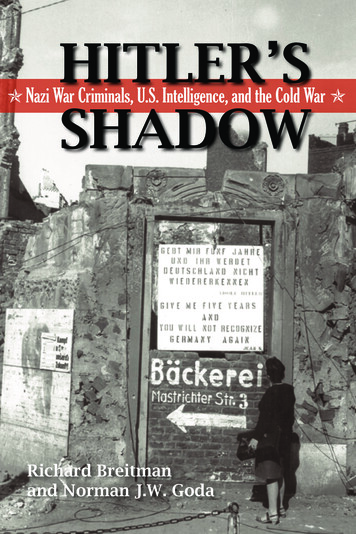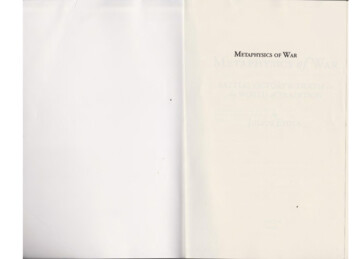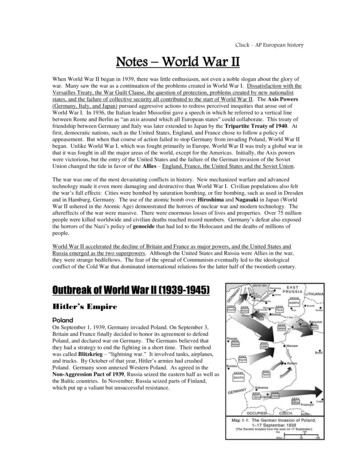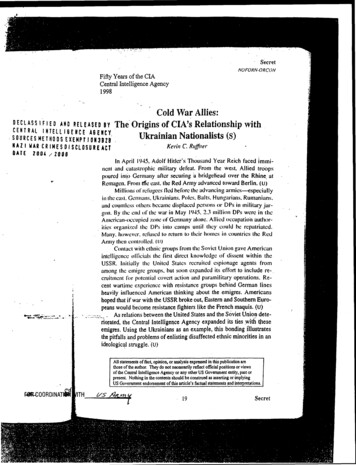
Transcription
SecretNOFORN-ORCONFitly Years of the CIACentral Intelligence Agency1998DECLASSIFIED AND RELEASED BYCENTRAL INT ELLIGENCE AGENCY. SOURCES METHODS EXEMPTION3B2BNAZI WAR CR IM ESDISCLOSURE ACTDATE 2004 /2008Cold War Allies:The Origins of CIA's Relationship withUkrainian Nationalists (s)Kevin C RuffrerIn April 1945, Adolf Hitler's Thousand Year Reich faced imminent and catastrophic military defeat. From the west. Allied troopspure() into Germany after securing a bridgehead over the Rhine . atRemagen. From die east. the Red Army advanced toward Berlin. (U)Millions of refugees fled belbre the advancing armies—especiallyin the east. Germans, Ukrainians. Poles. Baits. Hungarians. Rumanians.and countless others became displaced persons or DPs in military jargon. By the end of the war in May 1945. 13 million DPs were in theA merican-oceupied zone of Germany alone: Allied occupation authorities - organized the DPs into camps until they could he repatriated.Many, however, refused to return to their homes in countries the RedArmy then controlled. (u)Contact with ethnic groups from the Soviet Union gave Americanintelligence officials the first direct knowledge of dissent within theUSSR. Initially the United States recruited espionage agents fromamong the emigre groups, but soon expanded its effort to include re-.cruitment Itn potential covert action and paramilitary operations. Recent wartime experience with resistance groups behind German linesheavily influenced American thinking about the emigres. Americanshoped that if war with the USSR broke out, Eastern and Southern Europeans would bedome resistance fighters like the French maquis. (II) . As relations between the United States and the Soviet Union deteriorated, the Central Intelligence Agency expanded its ties with theseemigres. Using the Ukrainians as an example, this bonding illustratesthe pitfalls and problems of enlisting disaffected ethnic minorities in anideological struggle. (U)All statements of fact, opinion, or analysis expressed in this publication arethose of the author. They do not necessarily reflect official positions or viewsof the Central Intelligence Agency or any other US Government entity, past orpresent. Nothing in the contents should be construed as asserting or implyingUS Government endorsement of this article's factual statements and interpretations.1414-COORDINATRARITH19Secret
Cold War AlliesSecretHesitant First Encounter(u)American intelligence had its first tentative encounter with Ukrainian emigre groups as early as April 1946, marking the beginnings ofone of the earliest and most controversial covert action projects of theCold War:' (c)The Strategic Services Unit (SSU. the successor to the wartime Office of Strategic Services, or OSS. and precursor to the Central intelligence Group and Central Intelligence Agency) learned about anti-SovietUkrainian resistance movements that continued after the war in WesternEurope.' Boleslav A. Holtsman, SSU's X-2 (Counterintelligence) representative in Munich, became the primary American contact with Ukrainian leaders in the American zone in Germany.' By September 1946. ' A description of the first contact between American intelligence and the Ukrainian int-'annalists is found in (Zsolt Aradil to Chief of Mission. "Belladonna Project." 24 June1946. Information Management Staff Job Box 168. Folder 5. (S). For a request to vet various Ukrainian clerics as SI agents. see Cable. Vienna to SSU. War Department, 13 June 1946, IN 38136. Infomation Management StuffJoh C Box3. Folder 25. (S). A week earlier. SI/Austria designated the American-Ukrainian contactas Project Belladonna. Alfred C. Ulmer. Jr. to Chief. Secret Intelligence Branch. SSU/nerinanv. "Project Belladonna." 7 June 1946. Information Management Staff Job.2 Box 168. Folder 5. (s).SSU disseminated what it knew about the Ukrainians. (heir various factions. and theextent of collaboration with the Germans in SAINT. AMZON to SAINT. "UkrainianNationalist Movements." 24 June 1946. LWX-485. in WASH-INT-REG-163, RecordGroup 226. (OSS Records), Entry 108A. Box 284. (no folder listed). National Archivesand Records Administration. SSU's London station response to this report is found inSAINT. London to SAINT. AMZON. "Ukrainian Nationalist Movements." 16 July1946. XX-12288. in WASH-REG-INT-169. Record Group 226, IOSS Records). Entry109. Box 91, Folder 133. National Archives and Records Administration. (u)' Bill Holtsman served as a translator with OSS in Europe until his discharge in early1946. He received an appointment as Intelligence Officer with SSU/X-2 in March 1946and joined the Office of Special Operations (OSO) in October 1946. Holtsman transferred frtim Munich to Berlin in 1948 to work on Polish operations and returned to theUnited Spies in 1953. Personnelfile,Boleslav A. Hoksinan. Office of Human Resources Job Box 29. (S): and Boleslav A. Holtsman. interview by Kevin C.R u finer. tape recording, Arlington. VA, 3 November 1993 (hereafter cited as Holtsman,interview). Recordings. transcripts, and notes of this interview and subsequent interviews are on file in the CIA History Staff. Holtsmananade preliminary contact with thethrough.:his:Russian sources in July 1946 and reported what he had learnedin "Ukrainian Groups Now in Germany (General Info)," 17 August 1946, LWX-965, inWASH-REG-INT-163, Record Group 226. OSS Records, Entry 108A, Box 285, (nofolder listed), National Archives and Records Administration. (u)Secret4. 20
BoImlay Adfoltsman. SSU:v counterintelligence officer in Munich, establishedcontact with (Jkrainkni nationalists in /946. iriwn, nutnexy qffl.A. llonsman)Ulcrainian sources gave Holtsman several reports dealing with the organization of Soviet intelligence in western Europe.' (S)Three problems prevented immediate and close collaborationbetween SSU and the Ukrainian emigres. Most importantly, Americanintelligence was woefully ignorant of the different Ukrainian groupsand theft' aims. Col. William Quinn, Director of SSU, recommended.gathering intelligence about the history, reliability, and motivation ofthe disparate Ukrainian emigre organizations before "major steps aretaken to exploit them for intelligence purposes."' (s)A second problem was the war record of some anti-CommunistUkrainians. The struggle between the Wehrmacht and Red Army awakened and inflamed ancient rivalries and hatreds in Ukraine; many'SAINT to SAINT, Bern, "Ukrainian Nationalist Movement," 27 September 1946,X-8363, Information Management Staff JobBox I , Folder 9, (s).'Strategic Services Unit, "Ukrainian Nationalist Organizations," Intelligence Brief No.13, 15 October 1946, in Zsolt Aradi, "Ukrainian Nationalist Movement: An InterimBox 5 (s).Study," October 1946, HS/CSG-2482, History Staff Joba .2r.21aSecret
Cold War AlliesSecretUkrainians despised Poles and Jews as well as Soviet Communists.Ukrainians served in the German army and had been linked to Naziatrocities on the Eastern Front. (S). Motivation and reliability were final SS U concerns. Quinn considered the Ukrainians "adroit political intriguers and past masters in theart of propaglinda" who would not hesitate to use the United States fortheir own ends. Moreover, emigre groups in general—and Soviet ethnicminority groups in particular—were obvious targets of Soviet penetration and manipulation.' (S)Ukrainian Personalities and Groups (U)Zsolt Aradi, a Hungarian consultant with SSU. was instrumentalin establishing American intelligence contacts with the Ukrainians.Aradi had written "The Ukrainian Nationalist Movement" for SSU inOctober 1946, and used his ties with Ukrainian church officials at theVatican to meet emigre leaders in Germany. (S).Aradi initially worked with Father Ivan Hrinioch and Yury Lopatinsky, members of the Ukrainian Supreme Liberation Council (UHVRor Ukminska holovna vyzvolna rod:). Hrinioch. a Greek Catholic priestand longtime Ukrainian nationalist, served as the UHVR's second vicepresident while Lopatinsky acted as liaison between UHVR and thearndia),Ukrainian Insurgent Army, UPA (or UkrainskaAmerican concern about using emigre groups is seen in SAINT to SAINT. AMZON,untitled memorandum. 12 August 1946. X-8014. Information Management Staff JobC3 Box 1 (S): SAINT to SAINT. AMZON. "Ukrainian Natio n,d;v1 Move.ment," 19 September 1946. X-8276, Information Management Staff Job C.Box I(S): and SAINT. AMZON to SAINT. "White Russians-Vetting policy." 31 August 1946, LWX-1058. Information Management StallJob CBox Us).Secret22
Cold War AlliesSecretIIZroll Atztdi km right) used his littican lies to etrand Us intelligence'sawareness ni ihe Ukrainian r( q.stattce inurement. Wiwi') twomesy 4,1rtui koirrisastill itiUkraine fighting the Soviets.' UHVR's claims that the UPA was .engaged in a fierce struggle against Soviet troops in Ukraine attractedAmerican interest and eventual support. (S)Aradi also met Mykola Lebec!: a fierce nationalist and key figurein the Ukrainian liberation movement. Lebed, one of the founders of the0 rganizacya Ukrainskycli Narianalt iv, or Organization of Ukrainian' Hrinioch (his name is spelled numerous ways) was the most important Ukrainian con- tact with the Americans during this time period. Born in 1907, Hrinioch grew up inwestern Ukraine where he was ordained in the Church and became an active Ukrainiannationalist While one American ease officer noted that "subject was in contact with theQISIGerman Intelligence Service) during the early stages of the German campaign inGalicia, "-American intelligence officers found Hrinioch to be "very well informed andhighly intelligent" as well as "incorruptibly honest" Hrinioch, in fact, served as thechaplain of the infamous Ukrainian Nachtigall Legion of Ukrainian Nationalists, which:collaborated with the Nazis and played a major role in the 1941 proclamation of Ukrainian statehood. Hrinioch had the operational cryptonym of CAPARISON. Hriniochserved after the war in his clerical role and by 1982 he had been elevated to the rank ofPatriarchal Archimandrite. (bid; and Acting Chief, Munich Operations Base, Memorandum to Richard M. Helms, Chief, Foreign Branch M, "Personal Record of CAPARISON," 6 May 1949, MGM-A-1148, (S), in Ivan Hrinioch, File C 2I nformation Management Staff files. (S) See also Ivan Hrynokh [sic] entry, VoloaymyrKubijovyc, editor, Encyclopedia of Ukraine (Toronto: University of Toronto Press,1993). Lopatinsky was born in 1906 and served as an officer in the Polish Army. Healso joined the Nachtigall Legion and immigrated to the United States in 1953. YuriiLopatynsky [sic] entry, Kubijovyc, ed., Encyclopedia of Ukraine. (U)23Secret
SecretCold War Allies11; Iran Hrinioch, UHII's second vice president in Germany, was a leading pointor'eantact between the Ukrainian resistance movement and US intelligence. toSecret24
Yuty Lopatinsky, one of the first Ukrainian contacts (c)25Secret
'Wyk la Lebed, a fervent Ukrainian nationalist, served as theUHVR's foreign minister (c)
Cold War AlliesSecretNationalists (OUN), served as the foreign minister of ZakordonnePredstc-tvnyt,sivo UHVR or Foreign Representation of the Ukrainian Supreme Liberation Council. Lebed fervently believed in Ukrainian inde pendence, but was controversial. Poland sentenced him to death (latercommuted to life in prison) for his involvement in the assassination ofthe Polish Minister of the Interior in 1934.(S)Aradi . .dubbed this group of Ukrainians as Referat-33 (or R-33)and discussed its members' personalities in an operational report of27 December 1946. Hrinioch. Lebed, and Lopatinsky, he wrote,were "determined and able men, but with the psychology of the hunted. They are ready to sacrifice their lives or to commit suicide at anytime to fUrther their cause or to prevent security violations, and theyare equally ready to kill if they must." "It is always necessary to remember," Aradi- added. "that they have an almost religious worshipof their nation and distrust anything foreign: first and foremost. Polish; then Russian: then German." Nonetheless, Aradi thought themuseful if the Americans treated them properly." (S)Stefan Bandera was not a member of R-33, but was another personality—perhaps the personality of the Ukrainian emigre community—that had to be recognized. According to an OSS report ofSeptember 1945, Bandera had earned a fierce reputation for conductinga "reign of terror' during World War IL He led the largest faction ofOUN (which split when the war broke out), and Andrey Melnik led thesmaller. Both factions participated in terrorist activities against Polishofficials before the war. and Ukrainian nationalists allied themselveswith their Nazi "liberators" during the first days of Operation Barbarossa in 1941. Even though OUN's enthusiasm diminished after the Nazisfailed to support Ukrainian statehood, many Ukrainians continued tofight alongside the Germans until the end of the war. At the same time,' Lebed was born in 1909 and organized the youth wing of the OUN in the early 1930s.For more:information on Lebed. see Mykola Lebe,d, File C InformationManagement Staff files (S), and Mykola Lebed entryKubijovyc, ed., Encyclopedia ofUkraine. (u) ' KILKENNY, Operational Memorandum, MGH-39I , "Operation Belladonna." 27 December 1946,25 pp., Political and Psychological Staff records, Job c Box I(hereafter cited as "Operation Belladonna," 27 December 1946) (S). Referat-33 (R-33)included the following members: Hrinioch, Lebed, Lopatinsky as chiefs; MyronMatvieyko (chief of the OUN's security branch); and Yaroslav Stetsko (head of theAnti-Bolshevik Bloc of Nations). (s)' "Operation Belladonna," 27 December 1946, p. 17. (s)27Secret
Myron Matvieyko, chief of the OUN's security branch, laterdefected to the Soviets. to
Nazis rounded up OUN members and placed them in concentrationcamps." (U)Which, groups had the best claim to legitimacy and popular support? , Aradi drew on his contacts and reported in December 1946 that"after a thorough study of the Ukrainian problem and a comparison ofinformation from several sources in Germany. Austria, and Rome,source [Aradij- believes that UHVR, UPA. and OUN-Bandera are theonly large and efficient organizations among Ukrainians." Based on intelligence that leaders of the UHVR had provided. Aradi decided thatthis group "is recognized as having the support of the younger generation and of Ukrainians at home. - He theorized that opposition to UHVRin Ukrainian circles arose "because the organization is independent andforceful and has always .refused to collaborate with Germans. Poles orRussians." 1 (S)The First Projects (u)In mid-1946, Aradi and Yoltsman launched two separate espionage and counterespionage projects for SSU/X-2 using Ukrainians stillin Germany. BELLADONNA drew upon Aradi's contact with Hriniochto collect information on the Soviet military. LYNX, under Holtsman'sdirection, focused on identifying Soviet agents in western Germany.Project TRIDENT replaced LYNX in early 1947; TRIDENT promised" Ukrainian collaboration with the Nazis is discussed in Boshyk. ed. Ukraine duringWorld War II, pp. 61-88. The historical backdrop to Ukrainian political activities isfound in John A. Armstrong. Ukrainian Nationalism. 2d ed. (New York: ColumbiaUniversity Press, 1963). For further information on Bandent. see Stefan Bandera, FileInformation Management Staff files (s).""Operation Belladonna." 27 December 1946, pp. 16-17. This report also enumeratesthe Ukrainian proposals for cooperation. A supplement to this report is found in KIL!. KENNY; Opetational Memorandum. "Belladonna Operations - 2." 27 December 1946,FSR0-985,MGH-430, 3 pp. Information Management Staff Job C.— .J Box 510, (S). Both reports were wntten by Aradi. but according to Gordon M. Stewart, "they arethe work of Zsolt Aradi and C. ." Gordon M. Stewart, Chief, IntelligenceBranch, to Helms, "Belladonna O peration." 2 January 1946 [19471, FSR0-1111, Information Management Staff Job rBox 511. (s).29Secret
SecretCold War Alliesbetter control of Ukrainian affairs and security." Project UKULELE,under Bill Holtsman's direction and an offshoot of LYNX/TRIDENT,drew upon the services of a double agent known only as SLAVKO.'' (S)In all three projects, Holtsman and Aradi used Myron Matvieyko,chief of OUN's security branch, Sluzba Bezpeka, as their primary contact in Munich. Using Matvieyko proved a mistake. He was an Abwehragent during the war and later exchanged information gained fromOUN's "bunkers" in Germany "for protection in the American Zoneand some minor operational supplies." 5 His reports soon became unreliable and his actions questionable, so CIA dropped him in 1950 for "ineptitude." In 1951 Matvieyko defected to the Soviets and denounced theentire Ukrainian emigre leadership as Nazi collaborators and tools ofthe "capitalist intelligence services." Matvieyko's defection confirmed some American and Ukrainian suspicions that he had been aSoviet double agent throughout his work with US intelligence. (S)Matvieyko's illegal activities during the late 1940s (includingmurder and counterfeiting) strained American willingness to work withthe Ukrainians in Germany." By the spring of 1947, Headquartersreported that "Washington does not feel that intelligence derived fromsuch Ukrainian groups is worth the time and effort which wouldnecessarily have to be expended on such a project. Experience hasFor details on these early SC Munich operations, see SCO. Memorandum for CDeputy Chief of Operations, "CE Operational Progress Report No. 5," 17February 1947, Information Management Staff Job C .3 Box 513, (S); "Operation Trident: Progress Report 1," 21 January 1947, risuurw y, MGH-642, (S); "Developments in the TRIDENT Project," 21 February 1947, HSC/OPS/026, MGH-900,(S); and SC Munich, "O peration TRIDENT," 15 June 1947, (S), in "Trident Project,"European Division Job C. J Box 4, Folder 20, (S) (hereafter cited as "TridentProject."). See also SC. AMZON to Foreign Branch M, "Progress of Munich Operations." 15 May 1947, HSC/0PS153, FSRO-1796, Information Management Staff Joba Box 516, Folder 5, (S). The identity of various US intelligence officers referred to by "AB" call numbers can be found in SC, AMZON to SC Washington, "ABNumbers and Location of SC Personnel," 12 March 1947, FSRO 1436, 1457, 1458, Information Management Staff Job aBox 514, Folder I, (s).14 SC, AMZON to Helms for SC, "urganization of Project UKELELE," 28 March 1947,HSC/OPS/35, FSRO-1547, Information Management Staff Job tBox 514,Folder 4, (s). "Quotation cited , in . SC, Munich, "CAPANEUS," 15 June 1947, (S), in "Trident *-01---t-t"7:42iereee'l" "16 English translation of Radio Kiev broadcast, "Broadcast for Ukrainians in the Emigration, .24 November 1960, in Matvieyko, :L Information Management Stafffiles. (S) For further information on Matvieyico's detection, see Pavel Sudoplatov andAnatoli Sudoplatov, Special Tasks: The Memories of an Unwanted Witness-A SovietSpymarter (Boston: Little, Brown and Company, 1994), pp. 257-259. (u)""Liquidation of Lt. Andrei Pechara," 3 June 1947, MGH-1399, (S), in "TridentProject." A description of other murders committed by Matvievko and the SB/OUN isfound in. rJanuary 1971, Clandestine Services Historical Program (CSHP) no C .3 retained inCIA History Staff files, pp. 148-160, (S), hereafter cited as CSHP For descriptionof Matvieyko's counterfeiting activities, see numerous reports in his 201 file. (s)t.Secret30
Cold War AlliesSecretshown that information derived from such organizations has been bothlow-grade and ideologically biased."" (S)Holtsman, in fact, dropped arrangements with the LYNX group inlate 1946 and focused on more limited contact under OperationTRIDENT. In doing so, he severed relations with Hrinioch (who hadbeen Aradi's source) while still maintaining contact with Matvidyko. Inthe meantime, OUN' s ongoing internal dissension further tested.American patience with the Ukrainians. After a stormy meeting in Germany in August 1948, the leaders of the ZPUHVR in Germany (principallyLebed and Hrinioch) broke with Bandera's OUN. The increasingly totalitarian attitude taken by Bandera and his stubbornness towards theWest constituted the main reasons behind this break." (S)Hiding Bandera (U)The Soviet Union's demand for repatriating all its citizens suspected of war crimes and collaboration with the Nazis Complicated Aradi's and Holtsman's work with the Ukrainians while they establishedinitial contacts with OUN and ZPUHVR. 2" American acquiescence inthe Soviet demand would damage relations with the Ukrainians. American refusal, on the other hand, would damage relations with the USSRin Germany. Citizenship issues further complicated the problem. Theredrawn borders of Poland and the USSR put portions of Ukraine inboth countries; hence, many Ukrainians claimed to be Polish citizensexempt from repatriation to the USSR. (S)The Soviets wanted Stefan Bandera. American intelligence officials recognized that his arrest would have quick and adverse effects onthe future of US operations with the Ukrainians. According to Aradi,Bandera's arrest:' ;:- Wouldlitiply to the Ukrainians that we as an organization areunable to protect them, i.e., we have no authority. In such a case,there is not any reason or sense for them to cooperate with us.SCO to Thurston, "CE Operational Progress Re port No.5," 17 February 1947, FSRO1 Box 513, (s).1306, Information Management Staff Job C."The background of this conference and the dissension between the OUN and ZPUHVR and other Ukrainian groups is discussed in Chief of Station, Karlsruhe (signed byJames Critchfield and r to Helms, "Project ICON: Postwar UkrainianExile Organizations in western Europe,' 30 pages, 20 October 1948, MGM-A-793, Po, Box I, Folder 5, (S). This report is herelitical and Psychological Staff Job C.after cited as Project ICON Report. (s)AB-51, AMZON to AB-43, Munich, "Stefan Bandera," 28 October 1946, FSRO-656(S) in Bandera, cj (s)31Secret
SecretCold War AlliesOne of the reasons why full cooperation between the UHVR andour organization has not developed yet is the suspicion of theseleaders that we will ultimately "betray" them. From the verybeginning they complained that Americans have no real interest inthem and that Communist-penetrated USA officers or officialswill trade them to Russia. This belief was shared by both the Bandera people and the conservative Ukrainians. (S)Aradi concluded that, "if it should be decided not to use these people and their organization for intelligence purposes, it would be betterto arrest not only Bandera, but all the leaders whose names and whereabouts are known to us."Headquarters disagreed with Aradeslassessment, and indeed hadnever put much credence in the "intelligence" the Ukrainians were providing. The Central Intelligence Group recognized that Bandera's extradition to the Soviet Union would be a blow to the undergroundmovement, bUt noted that his organization "is, as the field agrees,primarily [original emphasis] a terrorist organization." Harry Rositzke;the acting chief of Special Projects Division-Soviet (SPD :S), wrote on7 Janudry 1947 .that: The case of Bandera's extradition and our part in it brings to thefore the whole Ukrainian problem. If the sine qua non of Ukrainiancooperation is political, then we should cease all direct contact(original emphasis] immediately. We are not in a position to give it,and if we attempt to create the impression that we can, we canexpect only bad results, for it will become obvious sooner or laterthat the protection we offer is extremely fragile as factors beyondour control are brought into play. If we accept the premise thatpolitical support is out, we must also face the fact that in the longrun operations using the Ukrainians as an organized group willprobably turn out to be worthless—simply because without politicalsupport the Ukrainian nationalist groups will be decimated bySoviet pressure and demoralization. It is therefore difficult to seeBindelis prOblern as really significant. The effects of Bandera'sarrest will only be to precipitate an inevitable development. (S)'' SC AMZON to SC Washington, "Search for Bandera, Leader of the OUN," 20 November 1946;17SR0-766, and Attachment I (KILKENNY) (S), in Bandera, E.7 (3)iC ettM to SC AMZON, "Munich Contacts," 9 January 1947, X-9126, enclosingSPD-S, "AB-51 and KILKENNY's Views on the Effects of Bandera's Extradition,"7 -r imer; 1.91 , InformaIo,i ivicuidgemen( Staff Job C,3 Box 6. (s)
Cold War AlliesSecretThe day before he wrote this memorandum. Rositzke criticizedCIG for failing to develop Soviet strategic "Lambda targets" and protested that American intelligence was overinvolved in tactical operations in Europe. He was concerned about CIG's "hasty exploitation ofsources of opportunity, especially anti-Soviet emigres from the USSRand satellite countries, to the exclusion of actual penetration operations." He called for a concentrated American effort against the SovietUnion and a reduction of' CIG's "exploitation of such organized antiSoviet groups as the Ukrainians. Georgians. and Batts for penetratingthe USSR (which/ involves dangerous security and political hazards.—Rositzke's arguments apparently were persuasive, for by thespring of 1947 Munich base had orders to stop its work with the various emigre groups, especially the Ukrainians. and concentrate on other targets. The new chief of the Munich Operations Base. Cceased contact with the Ukrainians and CIG turned over IvanHrinioch and Mykola Lebed to the US Army as sources.'' (c)In December 1947 the National Security Council issued NSC 4-A,which had important consequences for CIA in general and the emigreprograms in particular. NSC 4-A gave the DC1 responsibility for conducting covert psychological operations. This meant that CIA couldnow take the offensive in ways not possible previously. (u)Before NSC 4-A the Central Intelligence Group tried unsuccessfully to use emigres to collect intelligence. With the NSC's directive,the newly formed Central Intelligence Agency could move toward active cooperation with them in other areas of activity. The change result. ed in part from CIA's first attempts to penetrate the Iron Curtain and--'-'.- :- .- ---lizticePtUthes fale-6f the Ukrainians (and other Eastern European emigregroups) with the CIA's efforts. (C)" Harry A. Rositzlce, Acting Chief, SPD-S, to Donald H. Galloway, Assistant Directorfor Special Operations, "Recommended Policy for Lambda Strategic Operations Pro, Box 4. (c)gram," 8 January 1947, Information Management-Staff Job C" Li Col. Ellington D. Golden, Region IV, 970th CIC Detachment, to CommandingOfficer, 970th CIC Detachment, "Hrynioch, Ivan," 18 November 1947, (C), enclosingSpecial Agent Camille S. Hajdu, Memorandum for the Officer in Charge, "Hrynioch.17 Nuvember 1947, (C), in ivan firynioch, Dossier XE-20-19 66, InvestigativeRecords Repository, US Army Intelligence and Security Command, Fort George G.Meade, Maryland (hereafter cited by dossier number, IRR, INSCOM). (c)33Secret
Cold War AlliesSecretDCI Roscoe H. Hillenkoetter initially opposed the employment ofemigre groups despite the pressure from other federal agencies, including the State Department and the Army. In early March 1948, FrankWisner, a former OSS officer and a member of the State Department'sPolicy Planning Staff, proposed that the State-Army-Navy-Air ForceCoordinating Committee (SANACC) form an ad hoc committee to explore the use of Soviet exiles. Under the authority of NSC 4-A, SANACC took up Wisner's proposal and circulated his paper, "Utilizationof Refugees from the Soviet Union in U.S. National Interest," as SANACC 395 on 17 March 1948. Shortly afterwards, SANACC's ad hoccommittee, comprising members from State, Army, CIA, and otheragencies, began considering the paper and its recommendations.' (U)Wisner proposed in SANACC 395 to "increase defections amongthe elite of the Soviet World and to utilize refugees from the SovietWorld in the national interests of the U.S." The paper noted the greatdissatisfaction of many Russians since the Bolshevik Revolution in1917 and the growth of Russian anti-Communism during the Germanoccupation in World War H. Wisner believed that at least 700,000 Russians were scattered in European DP camps and elsewhere. This figure,Wisner claimed, represented "the potential nucleus of possible FreedomCommittees encouraging resistance movements into the Soviet Worldand providing contacts with an underground." According to Wisner, theUnited States remained "ill-equipped to engage in the political and psychological conflict with the Soviet World," and the "Soviet satellite areas like the USSR are tending to become a terra incognito." Americanignorance of the Soviet Union in all fields and at all levels, he lamented,was profound and growing. (u)With SANACC's approval, Wisner planned to "remove presentdeterrents and establish inducements" to spur defectors among the Soviet elite, as well as to increase the utilization of these refugees "to tillthe gaps in our current official intelligence, in public information, andin our politico-psychological operations." The State Departmentrequested that CIA conduct the study in accordance with Paragraph 6 ofthe SANACC-395's recommendations and report its findings to thecommittee. "(u)" State-Army-Navy-Air Force Coordinating Committee 395, Utilization of Refugeesfrom the Soviet Union in U.S. National Interest, 17 March 1948, located in ScholarlyResources, Inc., National Security Policy of the United States, LM-54, Roll 32,SWNCC Case Files Nos. 382-402 March 1947-June 1949, National Archives andRecords Administration. (u)" Ibid. (u)" W.A. Schulgen, Acting Secretary, SANACC, to Members, 18 March 1948, SANA5983, LM-54, Roll 32, National Archives and Records Administration. (u)Secret34
Cold War AlliesSecretCaptain Alan McCracken (USN), CIA's Deputy Assistant Direct-Or. for Special Operations (DADS0),
NAZI WAR CR IM ESDISCLOSURE ACT DATE 2004 /2008 Cold War Allies: The Origins of CIAs Relationship with Ukrainian Nationalists (s) Kevin C Ruffrer In April 1945, Adolf Hitler's Thousand Year Reich faced immi-nent and catastrophic military defeat. From the west. Allied troops pure() into Germany after securing a bridgehead over the Rhine. at Remagen.

